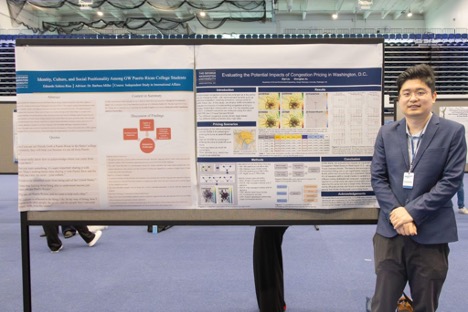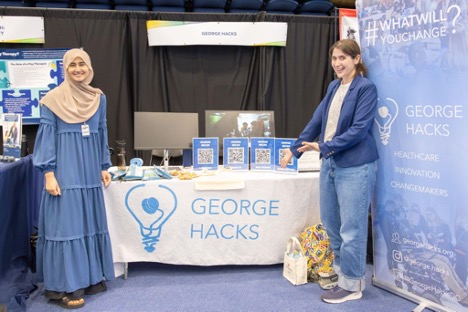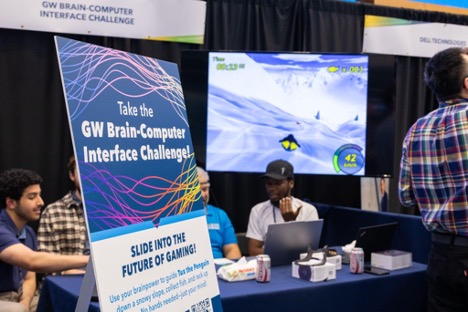Entering George Washington University (GW)’s Charles E. Smith Center during GW’s inaugural Innovation Fest was like entering any other festival—exciting and filled with anticipation. A saxophone performance could be heard over the speakers, and brightly colored balloons, exhibit booths, and posters could be seen across the arena. The celebratory environment matched the event's purpose, celebrating GW’s innovation as the most research-active university in the nation’s capital in terms of total and federal research expenditures.
There’s no shortage of innovation occurring at GW, and GW’s Office of the Vice Provost for Research hosted GW’s first InnovationFest to celebrate our prolific scholarly community and showcase the Revolutionaries who are building a better world.
The event featured inventions, demonstrations, posters, performances, books, and art in the same arena, creating an exciting, dynamic environment. Attendees could play a video game using their minds with the help of brain-computer interface technology from the lab of Computer Science’s Xiaodong Qu, hear from GW Engineering students about their state-of-the-art research, interact with a robot dog controlled by members of the Assistive Robotics and Tele-Medicine (ART-Med) lab, and chat with students from student-led organizations like George Hacks about how to get involved.
The event, sponsored by Dell Technologies, Digital Science, Zoom, Neat, and Global Solutions Institute, brought together students, faculty, and staff from across GW as well as fellow innovators from industry and government. Students had the opportunity to interface with representatives from Dell and Zoom about their innovations, giving them critical face time to discuss how their innovations may translate into industry applications.

Diyi Liu, a postdoctoral researcher from the Civil and Environmental Engineering (CEE) Department, chose to present his research on the potential impacts of congestion pricing on Washington, D.C. because his research presented surprisingly positive findings – congestion pricing may help alleviate traffic and pollutants if applied to the D.C. metropolitan area.
“Most of the anticipated changes from applying congestion pricing would be positive, so we want people to see that. That’s why we want to show this research in as many events as possible,” Liu shared.
Liu noted the event’s impressive attendance and the engagement of attendees. “I’ve only been standing here for about twenty minutes, and multiple people have shown interest in the research. Communication is vital in terms of research and application, and this event is a very meaningful part of that work,” he concluded.
Student-led organizations like George Hacks also had the opportunity to share their role in innovating with impact.

“George Hacks’ mission is healthcare innovation with social impact. When we were first told about InnovationFest, we immediately gravitated towards it because innovation is our mission and what we strive to do every day and in all of our events,” said Eugenie Pflieger, a cognitive neuroscience senior and co-director of George Hacks alongside junior Systems Engineering major Ben Yimaj.
For George Hacks, participating in InnovationFest was a no-brainer. The event’s alignment with their mission gave them the perfect opportunity to share about their work empowering the next generation of problem solvers in healthcare, including their annual George Hacks Innovation Hackathon and Kogan Makerspace events.
“We open up innovation to the rest of the community, even outside of the engineering school. Innovation is here!” exclaimed Amna Maqsood, a junior Engineering Management and Systems Engineering (EMSE) student and George Hacks’ Lead Technical Operations.
Amna’s remarks spoke to the work of George Hacks, but also to GW Engineering and GW writ large – innovation is right here in Foggy Bottom, and it’s here to stay.


